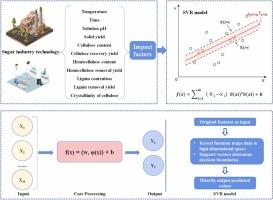预测各种预处理后木质纤维素生物质酶解产率的机器学习模型
IF 6.2
1区 农林科学
Q1 AGRICULTURAL ENGINEERING
引用次数: 0
摘要
本研究提出了六种机器学习架构的比较计算框架,利用跨越成分特征和预处理操作参数的多维输入来预测木质纤维素生物质的酶转化效率。支持向量回归(SVR)在所有模型中表现出较好的性能,目标变量测试集的R²值超过0.90。优化后的SVR对葡萄糖和木糖产率的决定系数(R2)分别为0.95和0.99。在预处理过程中,溶液pH是影响其化学组成、结构特性和固相收率的主要因素。通过SHapley加性解释(SHAP)和基于梯度的重要性量化,建立了特征-响应关系的第一主要解释,揭示了预处理诱导的结构修饰与随后的酶可及性之间的非线性相互依赖关系。设计了一个软件工具来精确预测不同预处理后葡萄糖和木糖的产量。这项研究为影响木质纤维素生物质预处理过程和酶解产量的关键决定因素及其协同关系提供了新的见解。本文章由计算机程序翻译,如有差异,请以英文原文为准。

Machine learning models for predicting enzymatic hydrolysis yields of lignocellulosic biomass after various pretreatments
This study presents a comparative computational framework of six machine learning architectures to predict enzymatic bioconversion efficiency of lignocellulosic biomass, utilizing multidimensional inputs spanning compositional signatures and pretreatment operational parameters. Support vector regression (SVR) demonstrated superior performance among all models, with R² values exceeding 0.90 for test sets of target variables. After optimization, SVR finally achieved coefficients of determination (R2) of 0.95 and 0.99 for glucose and xylose yields, respectively. Solution pH was identified as the dominant factor influencing chemical composition, structural characteristics, and solid yield during pretreatment. Through SHapley Additive exPlanations (SHAP) and gradient-based importance quantification, first-principal interpretations of feature-response relationships were established, revealing nonlinear interdependencies between pretreatment-induced structural modifications and subsequent enzymatic accessibility. A software tool was engineered to precisely predict glucose and xylose yields following different pretreatments. This study offers novel insights into critical determinants and their synergistic relationships affecting the pretreatment process and enzymatic hydrolysis yields for lignocellulosic biomass.
求助全文
通过发布文献求助,成功后即可免费获取论文全文。
去求助
来源期刊

Industrial Crops and Products
农林科学-农业工程
CiteScore
9.50
自引率
8.50%
发文量
1518
审稿时长
43 days
期刊介绍:
Industrial Crops and Products is an International Journal publishing academic and industrial research on industrial (defined as non-food/non-feed) crops and products. Papers concern both crop-oriented and bio-based materials from crops-oriented research, and should be of interest to an international audience, hypothesis driven, and where comparisons are made statistics performed.
 求助内容:
求助内容: 应助结果提醒方式:
应助结果提醒方式:


